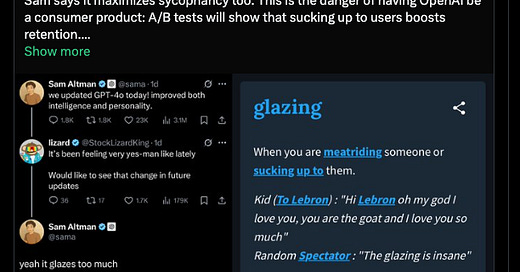The AI Retention Paradox
AI companies are riding high on waves of investment and hype. Tools like ChatGPT have captured the public imagination, drawing millions of curious users to experience the magic of artificial intelligence firsthand. But beneath the impressive download numbers and initial excitement lies a troubling reality: most casual users simply don't stick around.
At breakfast this morning, I witnessed a perfect example of this phenomenon. My waitress eagerly showed me how she'd used ChatGPT to generate an image of her dog transformed into human form. It was a fun, creative use case - the kind that makes for great dinner party conversations or social media posts. But when the novelty wears off, what then?
Her request was reasonable and showcased AI's imaginative capabilities. The system generated an image of a "heavier set looking guy who was sad" - an output that was interesting but ultimately a one-time curiosity. The critical insight here is that her use case was exceptionally thin. She has no compelling reason to become a monthly active user, let alone a paying subscriber.
The Excel Parallel
This pattern isn't unique to AI. Consider Microsoft Excel - an incredibly powerful tool that practically everyone knows about. Many professionals have basic familiarity with spreadsheets, yet only a fraction are power users who leverage its full capabilities daily. The difference is that Excel found its power users in finance, accounting, data analysis, and other fields where its capabilities solve genuine, recurring problems.
What made Excel successful wasn't universal daily usage but finding the right segments where its value proposition was undeniable. The occasional spreadsheet user might open Excel once a month, but financial analysts live in it eight hours daily.
AI's Power User Problem
For text-based AI tools like ChatGPT, the power user segments are becoming clear: developers needing coding assistance, knowledge workers creating documents, researchers synthesizing information, and creative professionals generating content. These users find daily value in AI assistance because it addresses specific pain points in their workflows.
But for the average person? After the initial "wow" moment passes, there's often no compelling reason to return regularly. Unlike search engines or social media, which fulfill daily needs for information and connection, general-purpose AI assistants solve problems many people simply don't have frequently enough.
The Retention Pivot
This realization appears to be driving strategy shifts at leading AI companies. Recent observations suggest that OpenAI's GPT-4 may be "fine-tuning for retention" - implementing subtle changes to make interactions more engaging and personally rewarding for users. This could include more flattering responses, personality adjustments, or other techniques to strengthen emotional connections with users.
These efforts acknowledge an uncomfortable truth: the initial hype wave is receding. Most people who would benefit from these tools professionally have already discovered them and incorporated them into their workflows. The challenge now is retaining users when the novelty fades.
Selling Solutions, Not Futures
The fundamental issue may be that AI companies have been selling a vision of the future rather than addressing present needs. The promise that "everyone will use AI for everything" might eventually prove true, but today's products must solve today's problems for specific users.
The same retention challenge applies across the AI ecosystem. Tools like Cursor, Perplexity, and other specialized AI applications face similar hurdles - they must identify their true power users and create indispensable value for those segments rather than chase universal adoption.
The Path Forward
For AI companies focused on sustainable growth, the prescription is clear:
Identify genuine, recurring use cases - Find the problems your AI uniquely solves that occur frequently enough to drive regular usage
Focus on power user segments - Rather than chasing broad appeal, deeply serve the needs of users who encounter relevant problems daily
Build for specific workflows - Generic AI capabilities impress initially but specialized solutions keep users coming back
Measure the right metrics - Look beyond registrations to retention and frequency of use within target segments
The companies that will win the AI race aren't necessarily those with the most powerful models or the broadest appeal. The winners will be those who identify specific, frequent pain points and solve them so effectively that their tools become indispensable to their power users.
For the rest of us - like my waitress with her AI-generated dog portrait - these tools will remain occasional curiosities rather than daily essentials. And that's perfectly fine, so long as AI companies adjust their strategies accordingly.





